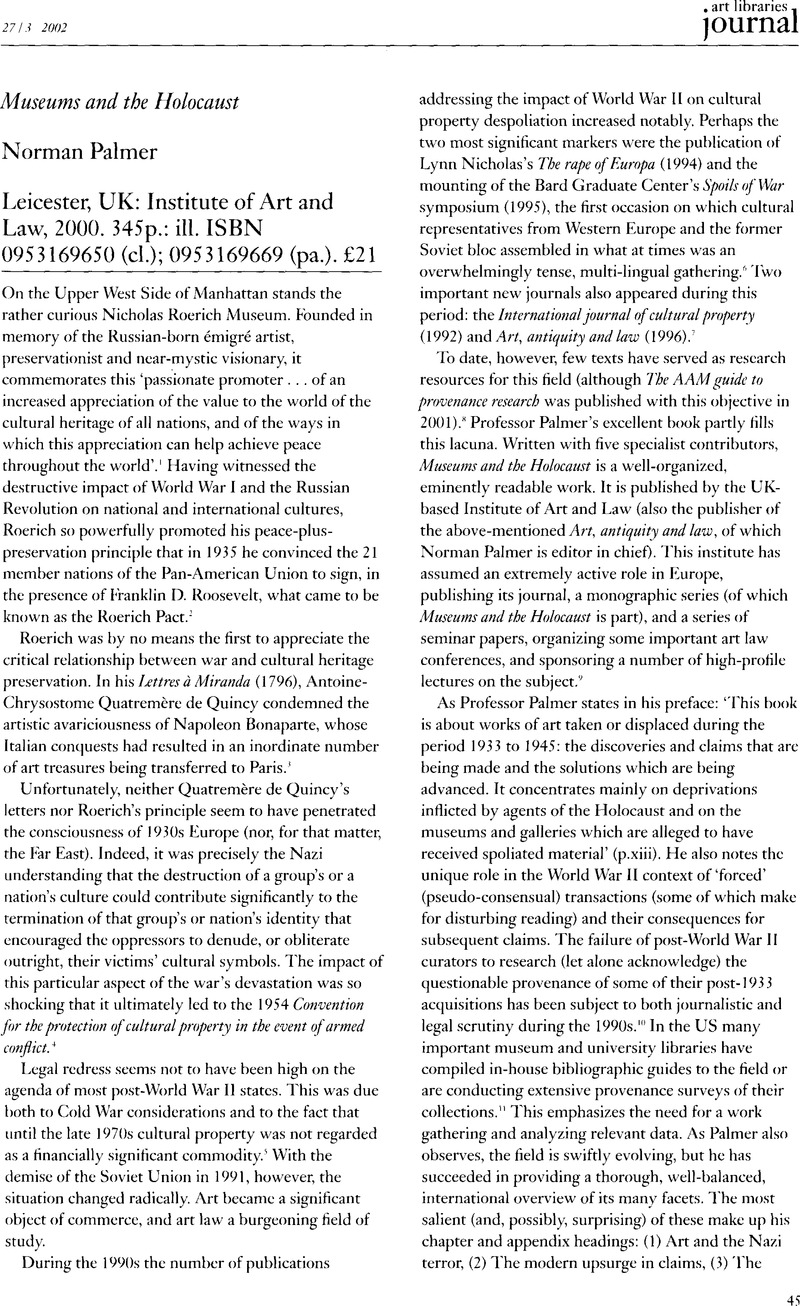No CrossRef data available.
Article contents
Museums and the Holocaust, Norman Palmer, Leicester, UK: Institute of Art and Law, 2000. 345p.: ill. ISBN 0953169650 (cl.); 0953169669 (pa.). £21
Published online by Cambridge University Press: 06 June 2016
Abstract
An abstract is not available for this content so a preview has been provided. Please use the Get access link above for information on how to access this content.

- Type
- Reviews
- Information
- Copyright
- Copyright © The Art Libraries Society 2002
References
1. The Nicholas Roerich Museum is at 319 West 107th Street, New York. See also http://www.roerich.org
Google Scholar
2.
Protection of artistic and scientific institutions and historic monuments: treaty between the United States of America and the other American republics, 15 April 1935. For the treaty’s text, its signatories, and President Roosevelt’s speech upon its signing (the US was amongst the signatories), see http://www.roerich.org/pact_and_banner.html and http://www.roerich.org/message.html. See also Ceremony signing of the Roerich Pact: treaty for the protection of artistic and scientific institutions and historic monuments at the White House, Washington, DC, in the presence of Franklin D. Roosevelt… by plenipotentiaries of the twenty-one American republics…
New York: Roerich Museum, 1935.Google Scholar
3.
Quatremère de Quincy, A.-C.
Lettres à Miranda sur le déplacement de l’art de l’Italie. Edited by Pommier, Edouard. Paris: Macula, 1989. See also Gould, Cecil. Trophy of conquest: the Musée Napoléon and the creation of the Ixmvre. London: Faber and Faber, 1965.Google Scholar
4. Adopted at The Hague, 14 May 1954. For the treaty’s full text and its ratifiers, see the UNESCO Web site at http://www.unesco.org/culture/laws/hague/htmleng/pagel.shtml. Interestingly, the US and the UK chose not to ratify this convention.Google Scholar
5. The art market’s rapid expansion is often seen as having begun with the auction at Sotheby’s, London, of the Robert von Hirsch collection in June 1978. The auction took place over nine days and was accompanied by four catalogues: (1) Old master drawings, paintings and medieval miniatures, (2) Medieval works of art, (3) Furniture and porcelain, (4) Impressionist and modern art.Google Scholar
6.
Nicholas, Lynn H.
The rape of Europa: the fate of Europe’s treasures in the Third Reich and the Second World War. London: Macmillan, 1994. Simpson, Elizabeth, ed. The spoils of war: World War II and its aftermath: the loss, reappearance and recovery of cultural property. New York: Abrams, 1997.Google Scholar
7.
International journal ofcultural property. Vol. 1-6. Berlin and New York: De Gruyter, 1992-1997; vol. 7-. Oxford: Oxford University Press, 1998-. See also http://www3.oup.co.uk/intjcp/. Art, antiquity and law. Vol. 1-. Leicester U.K.: Institute for Art and Law, 1996-.Google Scholar
8.
Yeide, Nancy H., et al. The AAM guide to provenance research. Washington D.C.: American Association of Museums, 2001.Google Scholar
9. For further information about the Institute for Art and Law, see http://www.ial.uk.com/.Google Scholar
10. See, for example, Feliciano, Hector. Ix musée disparu: enquête sur le pillage des oeuvres d’art en France par les Nazis. Paris: Austral, 1995; English translation, The lost museum: the Nazi conspiracy to steal the worlds greatest works of art. New York: Basic Books, 1997. Legal action occurred over two paintings by Egon Schiele on loan to the Museum of Modern Art from the Leopold Foundation in Vienna (Egon Schiele: the Ijeopold Collection, Vienna. Cologne: DuMont Buchverlag; New York: Museum of Modern Art, 1997). The suit claimed that the paintings had been forcibly obtained from their original, Jewish owners during the Nazi annexation of Austria, and restitution was demanded by their heirs. (This litigation is discussed extensively in Palmer’s Appendix III.)Google Scholar
11. Palmer cites, for example, the University of Chicago-based Web site Law-related resources on Nazi gold and other Holocaust assets, Swiss banks during World War II, and dormant accounts at http://www.lib.uchicago.edu/~llou/nazigold.html.Google Scholar




